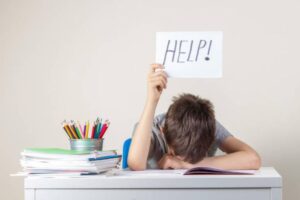 Anxiety is an increasingly common problem among children today. The Centers for Disease Control and Prevention reports that 7 percent of children aged 3 to 17 have a diagnosed anxiety disorder. Yet many believe that anxiety is vastly underdiagnosed and underrecognized in children.
Anxiety is an increasingly common problem among children today. The Centers for Disease Control and Prevention reports that 7 percent of children aged 3 to 17 have a diagnosed anxiety disorder. Yet many believe that anxiety is vastly underdiagnosed and underrecognized in children.
General jitteriness, palpitations, headaches, stomachaches, and not feeling well enough to go to school are often indications of anxiety. Anxiety can create problems falling asleep or staying asleep, or it can disrupt sleep with nightmares. It can also show up as problems remembering things or concentrating on things.
School refusal is a common problem among children with anxiety. It may take the form of not wanting to get out of bed on school mornings. Poor school performance can be a sign a child is preoccupied with worry. Because avoidance is a common, if maladaptive, approach to anxiety-provoking situations, anxious children may be unwilling to participate in experiences others eagerly embrace—going to friends’ houses, or family outings or vacations. Refusing to be separated from parents is a common sign of anxiety in children.
School performance is often a good barometer of children’s mental health. Anxiety can rob children of the ability to pay attention in school, and class engagement and participation may suffer as well as grades. Teachers are usually good observers of children’s patterns and are quick to spot changes in concentration, participation, and performance.
Where does anxiety come from?
Children can acquire anxiety through different ways, one of which includes early traumatic experiences. As well as this, some children may be consistently exposed to childrearing practices that transmit parental worries, that limit the acquisition of problem-solving skills, or that generate self-doubt. Too, children may become anxious through overexposure to information about worrisome things. While some degree of anxiety is normal, and children may need help learning to put anxiety in its place, they naturally differ in the degree to which they are aware of and sensitive to the physical components of anxiety. Some children may just feel anxiety more.
There is also widespread consensus that the emergence of social media is linked to high levels of anxiety in young people, particularly in adolescence. Despite enabling connectedness, the technology breeds social anxiety by providing new means of social quantification, nonstop opportunities for social comparison, and new pathways for social exclusion and bullying. Because social media never stops, it can generate a fear of missing out and doubts about self-adequacy that manifest in anxiety. Many studies show that social media actually increases children’s sense of isolation. Isolation, in turn, magnifies the perception of threat, and this can increase anxiety.
Unfortunately, children are far more likely to grow into their fears than out of them if anxiety is not addressed. Anxiety is considered a marker—a gateway to other mental health problems. The sooner it is addressed, the less likely it is to lead to serious mental health conditions. Without treatment anxiety is apt to persist, interfere with children’s social function and development, and wreak havoc on family life.
What treatment options exist?
Many studies show that the best way to treat the growing problem of childhood anxiety —better than a placebo, better than pharmaceutical approaches—is with cognitive behavioral therapy (CBT). It gives children the tools to disarm anxiety for a lifetime. Working with a counselor/therapist, usually in a course of 12 sessions, children acquire the ability to face their worries. They learn what triggers their anxieties and they learn that the perceptions of threat that send distress signals throughout their body are nevertheless false. They learn how to rationally challenge those perceptions, and to substitute negative thinking patterns with positive ones. CBT teaches the anxious to question their beliefs and learn that feared situations are safe.
As well as working with a Bozeman counselor, targeting the nutritional health of your child may be insightful as well. At the nCenter, we have a functional medical nutritionist and nutritional counseling services that can work to increase the knowledge of your child’s health and non-medicinal ways to address anxiety.
Neurofeedback is also a treatment option. After reviewing a Quantitative Electroencephalogram (qEEG), our neurofeedback practitioners can choose a protocol using Pulsed Electromagnetic Frequencies (pEMF) and/or Transcranial Direct Current Stimulation (tDCS) , Transcranial Alternating Current Stimulation (tACS) or Transcranial Random Noise Stimulation (tRNS) to balance your child’s brain so that it’s not as prone toward anxiety.
Remember that mental health problems are isolating, and children benefit from knowing that they are not alone in their experience of worry and that every single person on earth experiences anxiety at some time. You can be a part of calming your child by simply listening. Sometimes that makes all the difference.
If you are concerned that a child or other family member is struggling with anxiety, nCenter has trained practitioners and counselors in Bozeman and Belgrade, MT that want to help. A therapy, nutrition, neurofeedback approach or a combination of them all can help the worried person or child in your life develop the coping skills they need to succeed in the long term. Reach out to nCenter in Bozeman or Belgrade today for more information or to book an appointment.

